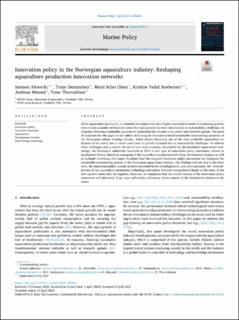| dc.contributor.author | Tella, Samson Afewerki | |
| dc.contributor.author | Osmundsen, Tonje Cecilie | |
| dc.contributor.author | Olsen, Marit Schei | |
| dc.contributor.author | Størkersen, Kristine Vedal | |
| dc.contributor.author | Misund, Andreas Ugelvik | |
| dc.contributor.author | Thorvaldsen, Trine | |
| dc.date.accessioned | 2023-10-31T07:45:27Z | |
| dc.date.available | 2023-10-31T07:45:27Z | |
| dc.date.created | 2023-06-19T10:06:08Z | |
| dc.date.issued | 2023 | |
| dc.identifier.issn | 0308-597X | |
| dc.identifier.uri | https://hdl.handle.net/11250/3099585 | |
| dc.description.abstract | While aquaculture production in a number of countries has been highly successful in terms of production growth, there is also a number of instances where the rapid growth has been curtailed due to sustainability challenges. In response, fostering sustainable aquaculture production has become a key policy and research agenda. The point of departure for this paper is the radical technological innovations based sustainable restructuring dynamics of the Norwegian salmon farming industry, which despite becoming one of the most profitable aquaculture industries in the world, has in recent years seen its growth curtailed due to sustainability challenges. To address these challenges and to enable the use of new areas currently inaccessible by the incumbent aquaculture technology, the Norwegian authorities launched in 2015 a new type of innovation policy instrument, known as development licences. Based on a mapping of the aquaculture production technology development projects as well as in-depth interviews, this paper elucidates how the targeted innovation policy instrument has instigated the sustainable restructuring process of the Norwegian aquaculture industry. Our findings indicate that in the short term, the innovation policy appears to have succeeded in the reconfiguration, and more precisely, the ’renewal’ process of the aquaculture production technology innovation networks (ecosystems) thanks to the entry of the new capable actors into the segment. However, we emphasise that the overall success of the innovation policy instrument will ultimately hinge upon sufficiently addressing certain aspects of the institutional failures in the sector. | |
| dc.description.abstract | Innovation policy in the Norwegian aquaculture industry: Reshaping aquaculture production innovation networks | |
| dc.language.iso | eng | en_US |
| dc.rights | Navngivelse 4.0 Internasjonal | * |
| dc.rights.uri | http://creativecommons.org/licenses/by/4.0/deed.no | * |
| dc.title | Innovation policy in the Norwegian aquaculture industry: Reshaping aquaculture production innovation networks | en_US |
| dc.title.alternative | Innovation policy in the Norwegian aquaculture industry: Reshaping aquaculture production innovation networks | en_US |
| dc.type | Peer reviewed | en_US |
| dc.type | Journal article | en_US |
| dc.description.version | publishedVersion | |
| dc.source.volume | 152 | en_US |
| dc.source.journal | Marine Policy | en_US |
| dc.identifier.doi | 10.1016/j.marpol.2023.105624 | |
| dc.identifier.cristin | 2155674 | |
| dc.relation.project | Norges forskningsråd: 301486 | |
| cristin.ispublished | true | |
| cristin.fulltext | original | |
| cristin.qualitycode | 1 | |

